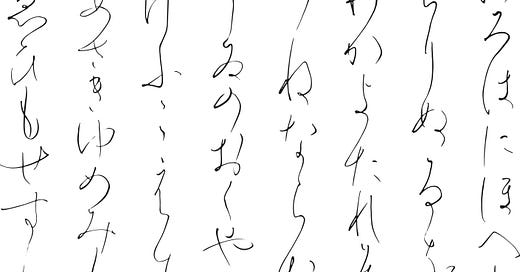Photo by Shutterstock, used with permission.
As November unfurls across Japan, a quiet transformation takes place. The air sharpens with a crispness that signals the coming winter, while the landscape blazes with the deep reds, golds, and ochres of autumn. The days grow shorter, and the light softens, casting long shadows that seem to hold the fleeting beauty of the season in their embrace. It’s a time that resonates deeply with the Japanese concept of wabi-sabi—the appreciation of beauty in impermanence and imperfection. Nowhere is this sensibility more evident than in the art and literature of Japan, where autumn’s transient nature has long been a profound source of inspiration.
Autumn in Traditional Japanese Art
In the traditional art of Japan, autumn is often depicted as a season of both vibrant life and quiet introspection. The ukiyo-e prints of the Edo period (1603-1868) offer a vivid portrayal of this time of year, with scenes of fiery maple leaves (momiji) cascading through the air or carpeting the ground. Artists like Utagawa Hiroshige captured the essence of autumn with masterful use of color and composition. In his famous series “One Hundred Famous Views of Edo,” the autumn landscapes are infused with a sense of serene melancholy, where nature’s beauty is intertwined with the passing of time.
Similarly, in the world of ink paintings, or sumi-e, autumn is often represented through minimalistic, yet evocative imagery. The sparse brushstrokes of artists like Sesshū Tōyō convey the stark beauty of bare branches against an empty sky, or the solitary fall of a single leaf. These works emphasize the fleeting nature of life, a theme central to the Japanese aesthetic experience of autumn.
The symbolism of autumn motifs in these artworks is rich and varied. The maple leaf, with its vivid colors, represents the beauty of change and the poignancy of impermanence. The chrysanthemum (kiku), blooming late in the year, symbolizes both endurance and the elegance of aging. These motifs are not just decorative; they carry deep cultural and philosophical meanings that resonate with the viewer’s sense of time and memory.
Autumn in Japanese Literature
Autumn has also been a central theme in Japanese literature, where it often embodies themes of change, nostalgia, and the passage of time. The haiku of Matsuo Basho, one of Japan’s most revered poets, capture the essence of autumn in a few, carefully chosen words. His haiku often juxtapose the beauty of the season with a sense of quiet sorrow, as in his famous verse:
“On a withered branch
A crow has settled—
Autumn evening.”
This poem, with its stark imagery and contemplative tone, reflects the introspective mood that autumn inspires. The crow, often a symbol of death or the unknown, perched on a bare branch against the backdrop of an autumn evening, evokes a deep sense of stillness and impermanence.
In more modern literature, authors like Yasunari Kawabata have continued to explore the themes of autumn. In his novel “Snow Country,” the changing seasons are a constant backdrop, with autumn representing the inevitable approach of winter and the passage of time. Kawabata’s lyrical prose captures the delicate balance between beauty and sorrow that defines the Japanese autumn, a time when nature’s final burst of color is both a celebration and a farewell.
Contemporary Art and Literature
In contemporary Japan, the influence of autumn remains strong in both visual art and literature. Modern painters and photographers continue to be drawn to the season’s rich colors and reflective mood. Exhibitions often feature works that explore the interplay between light and shadow, color and form, capturing the ephemeral beauty of autumn in new and innovative ways.
Similarly, contemporary writers draw on the traditions of the past while bringing fresh perspectives to the season. The works of authors like Haruki Murakami, for instance, often feature autumn as a backdrop to stories of introspection and change. In Murakami’s world, autumn is not just a season but a state of mind—a time for characters to confront their pasts and consider their futures.
Cultural Practices and Festivals
November is also a time of cultural festivals in Japan that celebrate the season’s beauty. The Chrysanthemum Festival, or Kiku Matsuri, held at various shrines and temples, showcases the flower in all its glory, with elaborate displays that highlight its cultural significance. These festivals are not only a celebration of nature but also an expression of the artistic and spiritual connection that the Japanese have with the changing seasons.
In tea ceremonies, the influence of autumn is evident in the choice of utensils, the setting, and the overall atmosphere. The quiet, meditative nature of the tea ceremony aligns perfectly with the contemplative spirit of autumn. The carefully selected tea bowls, often featuring autumnal motifs, and the use of seasonal ingredients in the accompanying sweets, reflect the deep appreciation of nature’s cycles that is at the heart of Japanese culture.
The Enduring Appeal of Autumn
Autumn’s allure in Japan is timeless, a season that continues to inspire artists and writers across generations. The vibrant colors, the crisp air, and the sense of change that autumn brings are more than just a backdrop; they are central to the Japanese experience of beauty and impermanence. As the leaves fall and the days grow shorter, autumn serves as a reminder of the fleeting nature of life, a theme that resonates deeply in the art and literature of Japan. In capturing the essence of this season, both traditional and contemporary works create a bridge between the past and the present, ensuring that the spirit of autumn remains a vital part of Japanese culture.
This exploration of autumn in Japanese art and literature not only highlights the enduring significance of the season but also invites us to reflect on our own perceptions of time, change, and beauty. Whether through the vivid colors of a Hiroshige print or the sparse lines of a Basho haiku, autumn in Japan offers a rich tapestry of inspiration that continues to captivate and move us.



